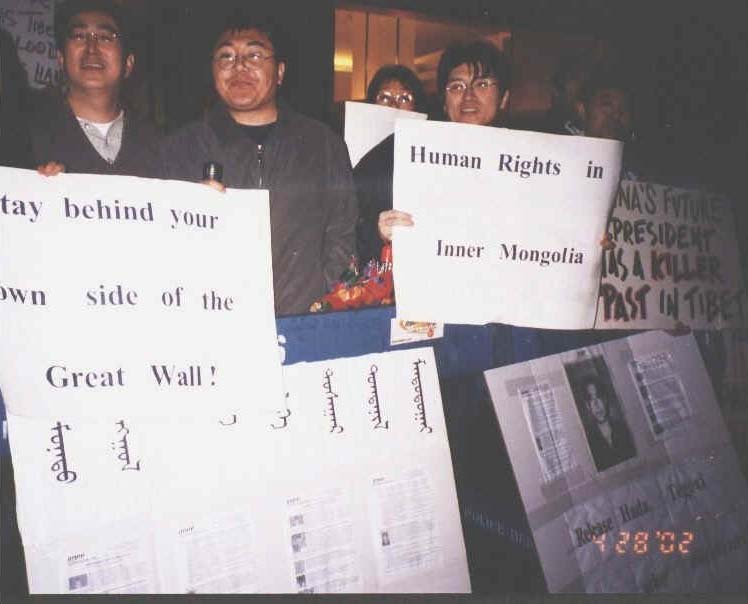|

RFA
2002-05-03
MC
[ By RFA Correspondent Shi Shan, English Translation by Hotala
Mergen ] May 1st is the 55th anniversary of the establishment
of Inner Mongolia Autonomous Region. Inner Mongolians who
live in the United States launched demonstration to protest
the oppression over the Mongols and the plundering of Inner
Mongolia's natural resource by China since more than fifty
years. Our correspondent Shi Shan reports:
VOICE
The demonstration organized by Inner Mongolian People's Party,
was originally planned to be in front of the Chinese embassy
in the US. But because of Chinese vice president Hu Jintao's
on-going visit to Washington D. C., the demonstration was
shifted to be held in front of the hotel where Hu stayed.
In front of Sheraton Hotel, gathered about two to three hundred
people, including both people who came to welcome and to demonstrate.
The welcome group being organized by the officials of Chinese
embassy, included Chinese students and scholars from nearby
universities. The demonstrators included free Tibet organizations,
Falungong practitioners, Xinjiang independence activists and
Mongolians.
In the bustled scene of demonstration, Oyunbilig, Executive
President of Inner Mongolian People's Party, talked to Radio
Free Asia correspondent.
ACT
Inner Mongolia Autonomous Region (IMAR) is the earliest among
the autonomous regions for ethnic minorities that were set-up
by the Chinese Communists government. It was established in
1947, even two years before the establishment of PRC itself.
According to Xinhua News Agency, on the occasion of the anniversary
of Inner Mongolia Autonomous Region, Oyunchimeg, Chairman
of IMAR, had expressed that the establishment of IMAR indicated
the creativity of CPC in combining Marxist theories on ethnicity
with the ethnic reality of China, and it is the beginning
of an ethnic autonomous regions system which suited the ethnic
conditions of China as well as the basic interests of all
ethnic groups.
To this, Executive President of Inner Mongolian People's
Party Oyunbilig holds a somewhat different point of view.
Oyunbilig expressed that the closer location of Inner Mongolia
and its geographical significance had made Inner Mongolia
being oppressed more seriously than Tibet and Xinjiang, since
the establishment of PRC. He said that since more than fifty
years, there were over 2,000 monasteries been destroyed and
tens of thousands of Mongolian monks were either imprisoned
or forced to be derobbed.
ACT
During the 60s of last century, the content of Cultural Revolution
in Inner Mongolia mainly was to crackdown on Inner Mongolian
People's Party. Oyunbilig says the case of Inner Mongolian
People's Party which later was proved to be a false one, had
caused death of 160,000, overwhelming number of whom being
ethnic Mongolians. He pointed out that since the 80s, because
of their demand for democracy and freedom, again thousands
of ethnic Mongolians have been arrested and been serving long-term
prison sentences, most famous among them being Hada of Southern
Mongolian Democracy Alliance.
Oyunbilig reveals that the current Inner Mongolian People's
Party was founded later and it is not directly related to
the one during the Cultural Revolution. He expresses that
all facts since the establishment of Inner Mongolia Autonomous
Region tells the Mongolians that such an autonomous is not
trustworthy. Therefore the goal of Inner Mongolian People's
Party is to seek a complete independence of Inner Mongolia.
|





